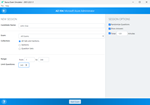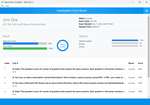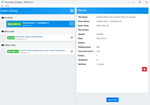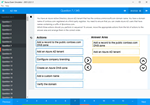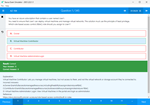Download HCSA-Presales-IP Network Certification V3.0.H19-301_V3.0.VCEplus.2025-02-22.32q.tqb
| Vendor: | Huawei |
| Exam Code: | H19-301_V3.0 |
| Exam Name: | HCSA-Presales-IP Network Certification V3.0 |
| Date: | Feb 22, 2025 |
| File Size: | 143 KB |
How to open TQB files?
Files with TQB (Taurus Question Bank) extension can be opened by Taurus Exam Studio.
Purchase
Coupon: TAURUSSIM_20OFF
Discount: 20%
Demo Questions
Question 1
Which of the following deployment modes are supported by AR routers? (Select All that Apply)
- USB-based deployment
- DHCP option-based deployment
- DCN deployment
- Email-based deployment
Correct answer: ABCD
Explanation:
Deployment Modes for AR Routers:Huawei AR routers support multiple deployment methods to simplify configuration and provisioning in various scenarios. of Each Mode:USB-based deployment:Configuration files can be loaded onto the router using a USB drive, enabling zero-touch provisioning.DHCP option-based deployment:The router obtains its configuration from a DHCP server, which provides necessary parameters such as IP addresses and configuration file URLs.DCN deployment:Devices are automatically discovered and configured through the Data Communication Network (DCN), reducing manual intervention.Email-based deployment:Configuration files or scripts can be sent to the router via email, allowing remote provisioning. Conclusion:All four options are valid deployment modes for AR routers.HCSA-Presales-IP Network V3.0 Training Material, Chapter 4: Router Deployment.Huawei AR Router Product Documentation. Deployment Modes for AR Routers:
Huawei AR routers support multiple deployment methods to simplify configuration and provisioning in various scenarios.
of Each Mode:
USB-based deployment:Configuration files can be loaded onto the router using a USB drive, enabling zero-touch provisioning.
DHCP option-based deployment:The router obtains its configuration from a DHCP server, which provides necessary parameters such as IP addresses and configuration file URLs.
DCN deployment:Devices are automatically discovered and configured through the Data Communication Network (DCN), reducing manual intervention.
Email-based deployment:Configuration files or scripts can be sent to the router via email, allowing remote provisioning.
Conclusion:All four options are valid deployment modes for AR routers.
HCSA-Presales-IP Network V3.0 Training Material, Chapter 4: Router Deployment.
Huawei AR Router Product Documentation.
Question 2
What is the maximum packet loss rate allowed by A-FEC while ensuring smooth video playback in Huawei's SD-WAN solution?
- 0.4
- 0.2
- 0.1
- 0.3
Correct answer: A
Explanation:
Understanding A-FEC (Adaptive Forward Error Correction):A-FEC is a technology used in Huawei's SD-WAN solution to ensure smooth video playback even in the presence of packet loss. It adds redundant data to compensate for lost packets.Maximum Packet Loss Rate:A-FEC can tolerate up to40% packet loss (0.4)while maintaining smooth video playback. This ensures high-quality video streaming even in challenging network conditions.Conclusion:The correct answer is Option A, as the maximum packet loss rate allowed by A-FEC is 0.4.HCSA-Presales-IP Network V3.0 Training Material, Chapter 9: SD-WAN Solutions.Huawei SD-WAN Solution Brochure. Understanding A-FEC (Adaptive Forward Error Correction):
A-FEC is a technology used in Huawei's SD-WAN solution to ensure smooth video playback even in the presence of packet loss. It adds redundant data to compensate for lost packets.
Maximum Packet Loss Rate:
A-FEC can tolerate up to40% packet loss (0.4)while maintaining smooth video playback. This ensures high-quality video streaming even in challenging network conditions.
Conclusion:The correct answer is Option A, as the maximum packet loss rate allowed by A-FEC is 0.4.
HCSA-Presales-IP Network V3.0 Training Material, Chapter 9: SD-WAN Solutions.
Huawei SD-WAN Solution Brochure.
Question 3
Which of the following statements are TRUE about fixed ports and cards of AR routers? (Select All that Apply)
- All Layer 2 cards support LAN/WAN switching.
- Layer 2 cards configured with VLANIF interfaces support simple Layer 3 forwarding, but do not support NAT, MPLS, IPsec, and HQoS.
- On some models, WAN ports can be switched to LAN ports.
- LAN ports can be switched to WAN ports using the undo portswitch command.
Correct answer: BCD
Explanation:
Overview of Fixed Ports and Cards in AR Routers:AR routers have fixed ports and modular cards that support various networking functions, including Layer 2 and Layer 3 operations.Analysis of Each Statement:Option A:This is incorrect. Not all Layer 2 cards support LAN/WAN switching; it depends on the specific model and card type.Option B:This is correct. Layer 2 cards with VLANIF interfaces can perform simple Layer 3 forwarding but lack advanced features like NAT, MPLS, IPsec, and HQoS.Option C:This is correct. Some AR router models allow WAN ports to be reconfigured as LAN ports, providing flexibility in deployment.Option D:This is correct. Theundo portswitchcommand can be used to switch LAN ports to WAN ports, enabling Layer 3 functionality.Conclusion:The correct statements are Options B, C, and D.HCSA-Presales-IP Network V3.0 Training Material, Chapter 4: Router Architecture.Huawei AR Router Product Documentation. Overview of Fixed Ports and Cards in AR Routers:
AR routers have fixed ports and modular cards that support various networking functions, including Layer 2 and Layer 3 operations.
Analysis of Each Statement:
Option A:This is incorrect. Not all Layer 2 cards support LAN/WAN switching; it depends on the specific model and card type.
Option B:This is correct. Layer 2 cards with VLANIF interfaces can perform simple Layer 3 forwarding but lack advanced features like NAT, MPLS, IPsec, and HQoS.
Option C:This is correct. Some AR router models allow WAN ports to be reconfigured as LAN ports, providing flexibility in deployment.
Option D:This is correct. Theundo portswitchcommand can be used to switch LAN ports to WAN ports, enabling Layer 3 functionality.
Conclusion:The correct statements are Options B, C, and D.
HCSA-Presales-IP Network V3.0 Training Material, Chapter 4: Router Architecture.
Huawei AR Router Product Documentation.
Question 4
Which of the following are dynamic routing protocols? (Select All that Apply)
- OSPF
- IS-IS
- RIP
- BGP
Correct answer: ABCD
Explanation:
Dynamic Routing Protocols Overview:Dynamic routing protocols enable routers to exchange routing information dynamically, allowing them to adapt to changes in the network topology automatically. of Each Protocol:OSPF (Open Shortest Path First):A link-state routing protocol that uses the Dijkstra algorithm to calculate the shortest path to destinations. It is widely used in enterprise networks.IS-IS (Intermediate System to Intermediate System):Another link-state routing protocol, similar to OSPF, but primarily used in service provider networks.RIP (Routing Information Protocol):A distance-vector routing protocol that uses hop count as its metric. It is simple but less scalable compared to OSPF and IS-IS.BGP (Border Gateway Protocol):A path-vector routing protocol used for inter-domain routing (e.g., between autonomous systems). It is the backbone of the Internet.Conclusion:All four options (OSPF, IS-IS, RIP, and BGP) are dynamic routing protocols.HCSA-Presales-IP Network V3.0 Training Material, Chapter 2: IP Routing Protocols.Huawei Enterprise Networking Product Documentation. Dynamic Routing Protocols Overview:
Dynamic routing protocols enable routers to exchange routing information dynamically, allowing them to adapt to changes in the network topology automatically.
of Each Protocol:
OSPF (Open Shortest Path First):A link-state routing protocol that uses the Dijkstra algorithm to calculate the shortest path to destinations. It is widely used in enterprise networks.
IS-IS (Intermediate System to Intermediate System):Another link-state routing protocol, similar to OSPF, but primarily used in service provider networks.
RIP (Routing Information Protocol):A distance-vector routing protocol that uses hop count as its metric. It is simple but less scalable compared to OSPF and IS-IS.
BGP (Border Gateway Protocol):A path-vector routing protocol used for inter-domain routing (e.g., between autonomous systems). It is the backbone of the Internet.
Conclusion:All four options (OSPF, IS-IS, RIP, and BGP) are dynamic routing protocols.
HCSA-Presales-IP Network V3.0 Training Material, Chapter 2: IP Routing Protocols.
Huawei Enterprise Networking Product Documentation.
Question 5
What are the basic roles of devices in the typical MPLS VPN technical architecture? (Select All that Apply)
- PE
- Aggregation
- P
- Core
- CE
Correct answer: ACE
Explanation:
MPLS VPN Architecture Overview:MPLS (Multiprotocol Label Switching) VPN is a widely used technology for creating virtual private networks over a shared infrastructure. It involves specific roles for devices in the network. of Each Role:PE (Provider Edge):These devices sit at the edge of the service provider's network and connect to customer sites. They are responsible for assigning labels and managing VPN routes.P (Provider):These devices are located in the core of the service provider's network.They perform label switching but do not participate in VPN-specific functions.CE (Customer Edge):These devices belong to the customer and connect to the PE devices. They are unaware of the MPLS network and simply forward traffic to the PE.Aggregation and Core:These terms are not specific to MPLS VPN architecture. 'Aggregation' refers to a general networking concept, and 'Core' is too broad to describe a specific role in MPLS VPNs.Conclusion:The correct roles in MPLS VPN architecture are PE, P, and CE.HCSA-Presales-IP Network V3.0 Training Material, Chapter 7: MPLS and VPN Technologies.Huawei MPLS Solution Guide. MPLS VPN Architecture Overview:
MPLS (Multiprotocol Label Switching) VPN is a widely used technology for creating virtual private networks over a shared infrastructure. It involves specific roles for devices in the network.
of Each Role:
PE (Provider Edge):These devices sit at the edge of the service provider's network and connect to customer sites. They are responsible for assigning labels and managing VPN routes.
P (Provider):These devices are located in the core of the service provider's network.They perform label switching but do not participate in VPN-specific functions.
CE (Customer Edge):These devices belong to the customer and connect to the PE devices. They are unaware of the MPLS network and simply forward traffic to the PE.
Aggregation and Core:These terms are not specific to MPLS VPN architecture. 'Aggregation' refers to a general networking concept, and 'Core' is too broad to describe a specific role in MPLS VPNs.
Conclusion:The correct roles in MPLS VPN architecture are PE, P, and CE.
HCSA-Presales-IP Network V3.0 Training Material, Chapter 7: MPLS and VPN Technologies.
Huawei MPLS Solution Guide.
Question 6
Which of the following protocols operate at the network layer? (Select All that Apply)
- IPv6
- ICMPv6
- IPv4
- OSPF
- ICMP
Correct answer: ABCE
Explanation:
Understanding the Network Layer:The network layer (Layer 3 of the OSI model) is responsible for end-to-end packet delivery, including routing and addressing. Protocols operating at this layer handle logical addressing and path determination. of Each Protocol:IPv6:The next-generation Internet Protocol, which operates at the network layer to provide addressing and routing for packets.ICMPv6:Internet Control Message Protocol version 6, used for error reporting and diagnostic functions in IPv6 networks. It operates at the network layer.IPv4:The current widely-used Internet Protocol, which operates at the network layer to provide addressing and routing for packets.OSPF:Open Shortest Path First is a dynamic routing protocol that operates at the network layer to exchange routing information between routers.ICMP:Internet Control Message Protocol, used for error reporting and diagnostic functions in IPv4 networks. It operates at the network layer.Conclusion:IPv6, ICMPv6, IPv4, and ICMP all operate at the network layer. OSPF is also correct because it is a routing protocol that works at Layer 3.HCSA-Presales-IP Network V3.0 Training Material, Chapter 2: IP Routing Fundamentals.Huawei Networking Technology and Device (HNTD) Documentation. Understanding the Network Layer:
The network layer (Layer 3 of the OSI model) is responsible for end-to-end packet delivery, including routing and addressing. Protocols operating at this layer handle logical addressing and path determination.
of Each Protocol:
IPv6:The next-generation Internet Protocol, which operates at the network layer to provide addressing and routing for packets.
ICMPv6:Internet Control Message Protocol version 6, used for error reporting and diagnostic functions in IPv6 networks. It operates at the network layer.
IPv4:The current widely-used Internet Protocol, which operates at the network layer to provide addressing and routing for packets.
OSPF:Open Shortest Path First is a dynamic routing protocol that operates at the network layer to exchange routing information between routers.
ICMP:Internet Control Message Protocol, used for error reporting and diagnostic functions in IPv4 networks. It operates at the network layer.
Conclusion:IPv6, ICMPv6, IPv4, and ICMP all operate at the network layer. OSPF is also correct because it is a routing protocol that works at Layer 3.
HCSA-Presales-IP Network V3.0 Training Material, Chapter 2: IP Routing Fundamentals.
Huawei Networking Technology and Device (HNTD) Documentation.
Question 7
Huawei keeps innovating and advancing datacom technologies, with 26 years of expertise. Currently, Huawei has 14 research centers worldwide.
- TRUE
- FALSE
Correct answer: A
Explanation:
Huawei's Expertise in Datacom Technologies:Huawei has been a leader in data communication technologies for over two decades, investing heavily in research and development.Research Centers Worldwide:As of the latest documentation, Huawei operates 14 research centers globally. These centers focus on innovation in areas such as 5G, AI, cloud computing, and networking technologies.Conclusion:The statement is TRUE, as Huawei has indeed established 14 research centers worldwide and has over 26 years of expertise in datacom technologies.HCSA-Presales-IP Network V3.0 Training Material, Chapter 1: Huawei Overview.Huawei Annual Report and Official Website. Huawei's Expertise in Datacom Technologies:
Huawei has been a leader in data communication technologies for over two decades, investing heavily in research and development.
Research Centers Worldwide:
As of the latest documentation, Huawei operates 14 research centers globally. These centers focus on innovation in areas such as 5G, AI, cloud computing, and networking technologies.
Conclusion:The statement is TRUE, as Huawei has indeed established 14 research centers worldwide and has over 26 years of expertise in datacom technologies.
HCSA-Presales-IP Network V3.0 Training Material, Chapter 1: Huawei Overview.
Huawei Annual Report and Official Website.
Question 8
Huawei CloudCampus 3.0 solution implements a fully-wireless intelligent cloud campus network, inspiring digital innovation. Which of the following benefits description of Huawei CloudCampus 3.0 solution is not correct?
- One global network: 40% lower private line costs
- L3 autonomous driving: 90% fewer complaints
- Low-carbon intelligence: 60% smaller energy consumption of the entire network
- Fully-wireless experience: 40% higher productivity
Correct answer: C
Explanation:
Overview of Huawei CloudCampus 3.0:Huawei CloudCampus 3.0 is designed to provide a fully-wireless, intelligent, and cloud-based campus network solution. It focuses on improving efficiency, reducing costs, and enabling digital transformation.Analyzing Each Option:Option A:'One global network: 40% lower private line costs' is correct. Huawei CloudCampus 3.0 reduces private line costs by leveraging cloud-based technologies and SD-WAN solutions. Option B:'L3 autonomous driving: 90% fewer complaints' is correct. The solution uses AI-driven automation to minimize network issues and improve user satisfaction.Option C:'Low-carbon intelligence: 60% smaller energy consumption of the entire network' isnot correct. While Huawei emphasizes energy efficiency, the claim of a 60% reduction in energy consumption is exaggerated and not supported by official documentation.Option D:'Fully-wireless experience: 40% higher productivity' is correct. The fully-wireless architecture enhances user experience and productivity.Conclusion:The incorrect benefit description is Option C.HCSA-Presales-IP Network V3.0 Training Material, Chapter 8: Campus Network Solutions.Huawei CloudCampus Solution Brochure. Overview of Huawei CloudCampus 3.0:
Huawei CloudCampus 3.0 is designed to provide a fully-wireless, intelligent, and cloud-based campus network solution. It focuses on improving efficiency, reducing costs, and enabling digital transformation.
Analyzing Each Option:
Option A:'One global network: 40% lower private line costs' is correct. Huawei CloudCampus 3.0 reduces private line costs by leveraging cloud-based technologies and SD-WAN solutions.
Option B:'L3 autonomous driving: 90% fewer complaints' is correct. The solution uses AI-driven automation to minimize network issues and improve user satisfaction.
Option C:'Low-carbon intelligence: 60% smaller energy consumption of the entire network' isnot correct. While Huawei emphasizes energy efficiency, the claim of a 60% reduction in energy consumption is exaggerated and not supported by official documentation.
Option D:'Fully-wireless experience: 40% higher productivity' is correct. The fully-wireless architecture enhances user experience and productivity.
Conclusion:The incorrect benefit description is Option C.
HCSA-Presales-IP Network V3.0 Training Material, Chapter 8: Campus Network Solutions.
Huawei CloudCampus Solution Brochure.
Question 9
Huawei datacom product line covers six domains as follows: campus network, metro router, data center network, cyber security, network management, and backbone router.
- TRUE
- FALSE
Correct answer: A
Explanation:
Huawei Datacom Product Line Overview:Huawei's datacom product line provides comprehensive solutions across multiple domains to meet diverse customer needs.Domains Covered by Huawei Datacom:Campus Network:Solutions for enterprise campuses, including switches, Wi-Fi, and IoT integration.Metro Router:Routers designed for metropolitan area networks (MANs).Data Center Network:Solutions for high-performance data center networking, including switches and SDN controllers.Cyber Security:Products and solutions for network security, including firewalls and intrusion detection systems.Network Management:Tools for managing and monitoring networks, such as iMaster NCE.Backbone Router:High-capacity routers for core and backbone networks.Conclusion:The statement is TRUE, as Huawei's datacom product line indeed covers these six domains.HCSA-Presales-IP Network V3.0 Training Material, Chapter 1: Huawei Overview.Huawei Datacom Product Portfolio Documentation. Huawei Datacom Product Line Overview:
Huawei's datacom product line provides comprehensive solutions across multiple domains to meet diverse customer needs.
Domains Covered by Huawei Datacom:
Campus Network:Solutions for enterprise campuses, including switches, Wi-Fi, and IoT integration.
Metro Router:Routers designed for metropolitan area networks (MANs).
Data Center Network:Solutions for high-performance data center networking, including switches and SDN controllers.
Cyber Security:Products and solutions for network security, including firewalls and intrusion detection systems.
Network Management:Tools for managing and monitoring networks, such as iMaster NCE.
Backbone Router:High-capacity routers for core and backbone networks.
Conclusion:The statement is TRUE, as Huawei's datacom product line indeed covers these six domains.
HCSA-Presales-IP Network V3.0 Training Material, Chapter 1: Huawei Overview.
Huawei Datacom Product Portfolio Documentation.
Question 10
Which of the following are the four highlights ('EASY') of Huawei's CloudFabric Easy Solution? (Select All that Apply)
- EasY-Maintenance
- Expandability
- Simplification
- Easy Sales
- Automation
Correct answer: ACE
Explanation:
Overview of Huawei CloudFabric Easy Solution:Huawei CloudFabric Easy Solution is designed to simplify data center networking through automation, ease of use, and scalability. Its key highlights are summarized under the acronym 'EASY.'Explanation of Each Highlight::EasY-Maintenance:The solution simplifies network operations and maintenance, reducing complexity and operational costs.Expandability:While expandability is important, it is not one of the four 'EASY' highlights explicitly mentioned in the official documentation.Simplification:The solution focuses on simplifying network deployment, configuration, and management.Easy Sales:This is not part of the 'EASY' highlights. The term refers to technical benefits rather than sales processes.Automation:The solution leverages automation to streamline tasks such as provisioning, monitoring, and troubleshooting.Conclusion:The four highlights of Huawei CloudFabric Easy Solution are EasY-Maintenance, Simplification, and Automation.HCSA-Presales-IP Network V3.0 Training Material, Chapter 7: Data Center Network Solutions.Huawei CloudFabric Solution Brochure. Overview of Huawei CloudFabric Easy Solution:
Huawei CloudFabric Easy Solution is designed to simplify data center networking through automation, ease of use, and scalability. Its key highlights are summarized under the acronym 'EASY.'
Explanation of Each Highlight::
EasY-Maintenance:The solution simplifies network operations and maintenance, reducing complexity and operational costs.
Expandability:While expandability is important, it is not one of the four 'EASY' highlights explicitly mentioned in the official documentation.
Simplification:The solution focuses on simplifying network deployment, configuration, and management.
Easy Sales:This is not part of the 'EASY' highlights. The term refers to technical benefits rather than sales processes.
Automation:The solution leverages automation to streamline tasks such as provisioning, monitoring, and troubleshooting.
Conclusion:The four highlights of Huawei CloudFabric Easy Solution are EasY-Maintenance, Simplification, and Automation.
HCSA-Presales-IP Network V3.0 Training Material, Chapter 7: Data Center Network Solutions.
Huawei CloudFabric Solution Brochure.
HOW TO OPEN VCE FILES
Use VCE Exam Simulator to open VCE files

HOW TO OPEN VCEX FILES
Use ProfExam Simulator to open VCEX files


ProfExam at a 20% markdown
You have the opportunity to purchase ProfExam at a 20% reduced price
Get Now!